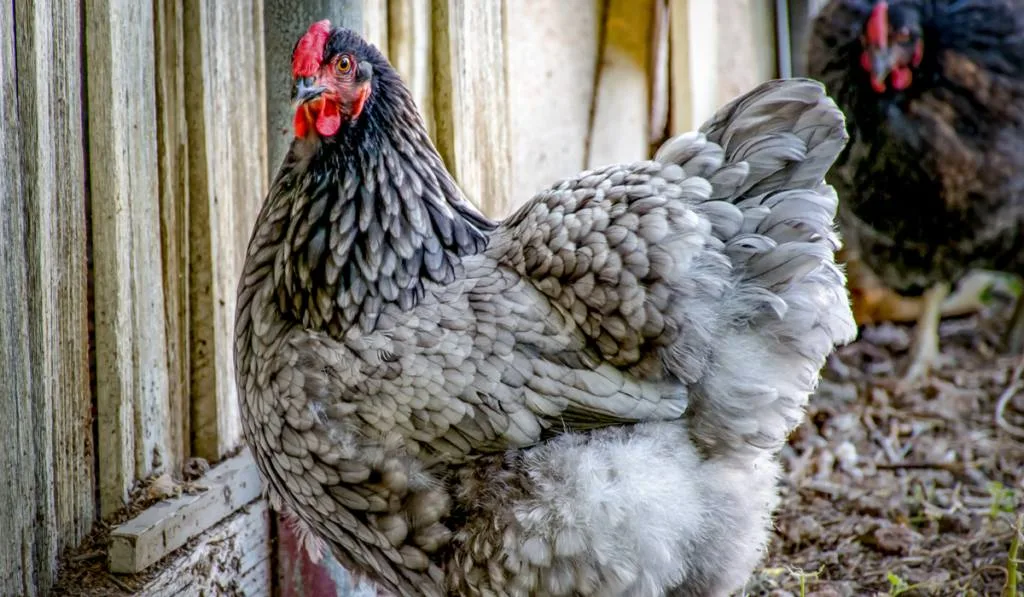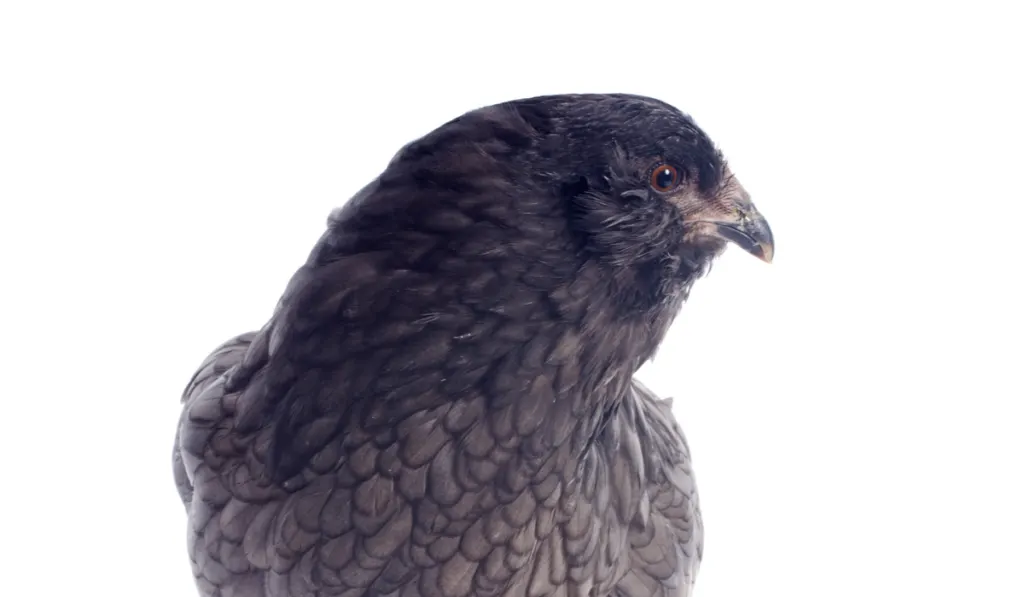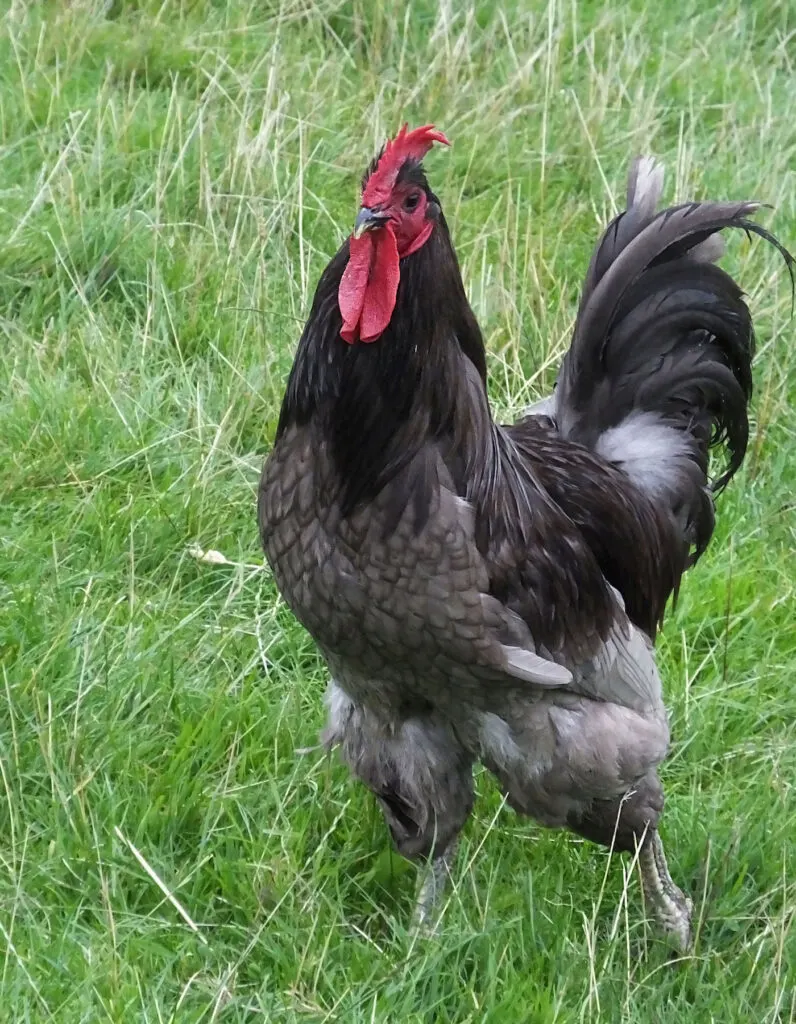Blue chickens are increasing in popularity, with more and more breeders integrating these genetics into common breeds.
Blue chickens are gorgeous. They look majestic as the sun hits their magnificent feathers. We’ve compiled a list of the best blue chicken breeds for this article but first, a quick look at what makes blue chickens, well, blue.
Table of Contents
The Genetics that Make Chickens Blue
Chickens are beautiful birds that come in all shapes and colors. Each one has distinct patterns and personalities.
Let’s look at the science behind blue chickens. It’s fascinating.

1. Genotypes
What is a genotype? It’s the unique genetic fabric of all living things, like you, me, and blue chickens.
Black (BB) and splash (bb) genes are the building blocks of the blue genotype in chickens. The BB-gene is the dilution, while the bb-gene is the wild-type. When combined, it creates the Bb-gene.
Breeders will take one black and one splash parent, then breed them to get 100% blue chicks. The chicks get one gene from each parent, which then makes it blue.
2. Phenotypes
Genotypes create phenotypes. These are the colors you see in chicken feathers. You will find a wide variety of blue among chickens because of the Bb genotype. It is a dilute gene, which is why there are so many shades.
Some blue chicks will look completely black, while others will only have a soft tinge of a pastel blue.
3. Self-Blue
Some chicken breeds naturally breed the beautiful blue color. It’s usually a lot lighter and often looks like lavender.
Self-blue chickens hatch 100% lavender chicks without the black (BB) or splash (bb) gene variations.
Self-blue breeds take time to create and many generations of breeding.
Blue Chicken Breeds
Now that we know a little more of the science behind blue chickens, let’s look at 15 of the most beautiful chicken breeds.
1. Blue Andalusian
The Blue Andalusian originates from Spain. They are beautiful fowls that lay about 150 eggs a year or 3 eggs a week.
They handle the heat fairly well but should have a fair amount of shade cover to protect them from heatstroke.
Blue Andalusians don’t like the cold. Make sure they have a safe, warm place to live during the colder months. They still lay eggs during winter, which is a tremendous bonus if you rely on your chickens for eggs.
Blue Andalusians are healthy birds that rarely suffer from common fowl diseases. They can be friendly but don’t enjoy being held. You will also need a large backyard or pasture because they become aggressive if cooped up in small spaces.

2. Blue Wyandotte
Blue Wyandottes have a history as far back as the 1880s. Named after the Native American Wyandotte nation, they are an American breed through and through.
They are broody hens that make splendid mothers and lay about 200 large eggs a year. You can also raise them for meat, hence their dual-purpose classification.
Blue Wyandottes are calm fowls and aren’t nosy. Interestingly, they love being cuddled but not for too long. They don’t get along with other chicken breeds but won’t be aggressive unless they feel provoked.
They have an average lifespan of 6-12 years. The American Poultry Association recognizes Blue Wyandottes and classifies them as dual-purpose.
3. Blue Australorp
Blue Australorp chickens come from Australia. The British brought them over to breed with Langshan chickens. They reached the shores of America in the 1920s.
Australorp chickens, whether blue or otherwise, were on the Livestock Conservancy’s threatened list. Their numbers are still low, but they moved to the Recovering Breed list a few years ago.
These dual-purpose chickens lay brown eggs throughout the year, even in extreme heat. They can lay 250 eggs a year and are exceptionally broody.
The American Poultry Association recognizes blue Australorp chickens.
In fact, one Australorp chicken is in the Guinness Book of World Records as the egg-laying champion of earth. She laid 364 eggs in one year.

4. Blue Ameraucana
Blue Ameraucana chickens have a distinct look that sets them apart from other breeds. They look like hawks. It tricks other predators from attacking your feathered friends.
They are a relatively new breed, having only come about in the 1970s. In 1984, the American Poultry Association accepted this breed, including the blue variant.
Blue Ameraucana chickens are friendly but don’t enjoy cuddles. Sometimes docile, other times skittish, these fowls enjoy socializing with other chickens.
Blue Ameraucana chickens start laying eggs a little later than other chicken breeds. They will lay around 150 eggs a year once they get started and their eggs are a light blue color.
5. Blue Bresse Gauloise
Bresse Gauloise chickens have a long history that dates back to 1591. They are native to France and most often come in white.
France’s poultry laws recognize Blue Bresse Gauloise chickens.
French and European laws dictate the way you raise these chickens because you must meet certain quality standards. For instance, you can’t give them any feed or medical intervention. You must leave blue Bresse Gauloise chickens to forage for food naturally.
They lay about 200 – 250 white eggs a year but only in season. Blue Bresse hens aren’t broody and are often nervous birds. The chicks are often aggressive towards each other, so that adds a challenge when raising them.

6. Blue Cochin
Blue Cochin chickens are rare. They came from China. Although, many people think their true origin is Vietnam because, in the 1840s, a French colony in that region was exporting them around the world.
The American Poultry Association recognizes the Blue Cochin breed. They classify it as an Asiatic breed, along with Brahma and Langshan chickens. Like the Australorp, Blue Cochins are a recovering breed after nearly reaching extinction.
Blue Cochin is one of two breeds that has frizzle chickens. Their feathers curl forward, giving them a unique appearance.
These fowls are popular because they are good egg layers and have a gentle character. Blue Cochin hens will lay between 180 – 200 eggs a year and prefer to do so in winter.
7. Blue Plymouth Rock
Breeders cross Andalusian males and Plymouth Barred Rock females to create the beautiful Blue Plymouth Rock chickens. Their plumage is a soft, grayish blue with a hint of lavender.
Blue Plymouth Rock chickens are dual-purpose and have recognition from the American Poultry Association. These hens lay around 300 large, brown eggs a year, even during the colder months.
Blue Plymouth Rock chickens are calm and curious fowls. They love exploring their surroundings and prefer free-range conditions.

8. Blue Copper Maran
The Blue Copper Maran originates from France. In the 1800s, breeds mixed their chickens with other wild game to create the Maran.
Only the French Blue Copper Marans gained recognition from the American Poultry Association, unlike their English cousins.
Blue Copper Marans are friendly fowls that live comfortably in confinement or free-range. They also mix well with other chicken breeds, so they are easy to raise. Some Maran chickens have feathered legs, so they need a little extra care.
Blue Copper Marans lay between 150 – 200 eggs a year. They produce large, brown eggs that sometimes come out very dark. As they grow older, their eggs become lighter and eventually turn white.
9. Blue Dutch Bantam
As the name suggests, Blue Dutch Bantam chickens come from the Netherlands. They imported birds from the Dutch East Indies in the 1880s and created the Bantam breed.
Interestingly, they first arrived in America in 1945 but quickly died out. In the 1970s, American breeders re-imported Bantams. They only entered the American Poultry Association’s records in 1992.
Blue Dutch Bantam hens are broody and lay about 160 white eggs a year. Their eggs are a lot smaller than other commercial breeds.
10. Rhode Island Blue
Rhode Island Blues are a cross between Rhode Island Reds and Australorp chickens. Most are blue all the way through but some have red feathers as well.
They lay between 200 – 250 large, brown eggs a year. Rhode Island Blue hens are broody.
Rhode Island Reds have a classification with the American Poultry Association, but it’s unclear whether the Blues have one, too.

11. Blue Jersey Giant
Blue Jersey Giants get their name because they are so big. Originally bred in the 1800s, they are the largest chicken breed in the world today.
Blue Jersey Giants are friendly fowls that happily live in barnyard runs or homesteads. In fact, many owners report that their Giants love cuddles and sitting on their laps. They enjoy sharing a home with other chicken breeds, too.
Hens produce about 150 large or extra-large eggs a year. If you want broody chickens, then The Blue Jersey Giant is for you.
Blue Jersey Chickens gained recognition from the American Poultry Association in 1922.
Final Words
These are some of the most popular blue chicken breeds you can raise. Their plumage will add a unique flair to your backyard flock. Most of these chicken breeds are dual-purpose and have great laying capacity.
Keep in mind that it’s best to raise most chicken breeds free-range as they love to forage for food and explore.
Resources
- https://www.backyardchickencoops.com.au/blogs/learning-centre/top-20-chicken-breeds-for-your-backyard-coop
- https://www.thehappychickencoop.com/17-best-blue-chicken-breeds-for-your-flock/
- https://thehipchick.com/blue-chicken-breeds/
- https://www.thehappychickencoop.com/andalusian-chicken/
- https://www.thefeatherbrain.com/blog/wyandotte-chickens
- https://www.pickeringvalleyfeed.com/2021-chicken-info/breed-info/blue-australorp/
- https://backyardpoultry.iamcountryside.com/chickens-101/blue-and-black-australorp-chicken-a-prolific-egg-layer/
- https://www.thehappychickencoop.com/ameraucana/
- https://www.domesticforest.com/bresse-gauloise-chicken/
- https://www.bresse-gauloise.org/
- https://www.mcmurrayhatchery.com/blue_cochins.html
- https://www.thehappychickencoop.com/cochin-chickens/
- https://www.freedomrangerhatchery.com/blue-plymouth-rock.asp
- https://poultrykeeper.com/chicken-breeds/dutch-bantams/
- https://www.poultryclubsa.co.za/dutch-bantam-breeders/
- https://www.mthealthy.com/birds/rhode-island-blue
- https://www.backyardchickens.com/threads/rhode-island-blue.1446847/
- https://www.backyardchickens.com/threads/rhode-island-blue.1446847/
- https://www.thefeatherbrain.com/blog/jersey-giant-chickens
- https://livestockconservancy.org/index.php/heritage/internal/jerseygiant
